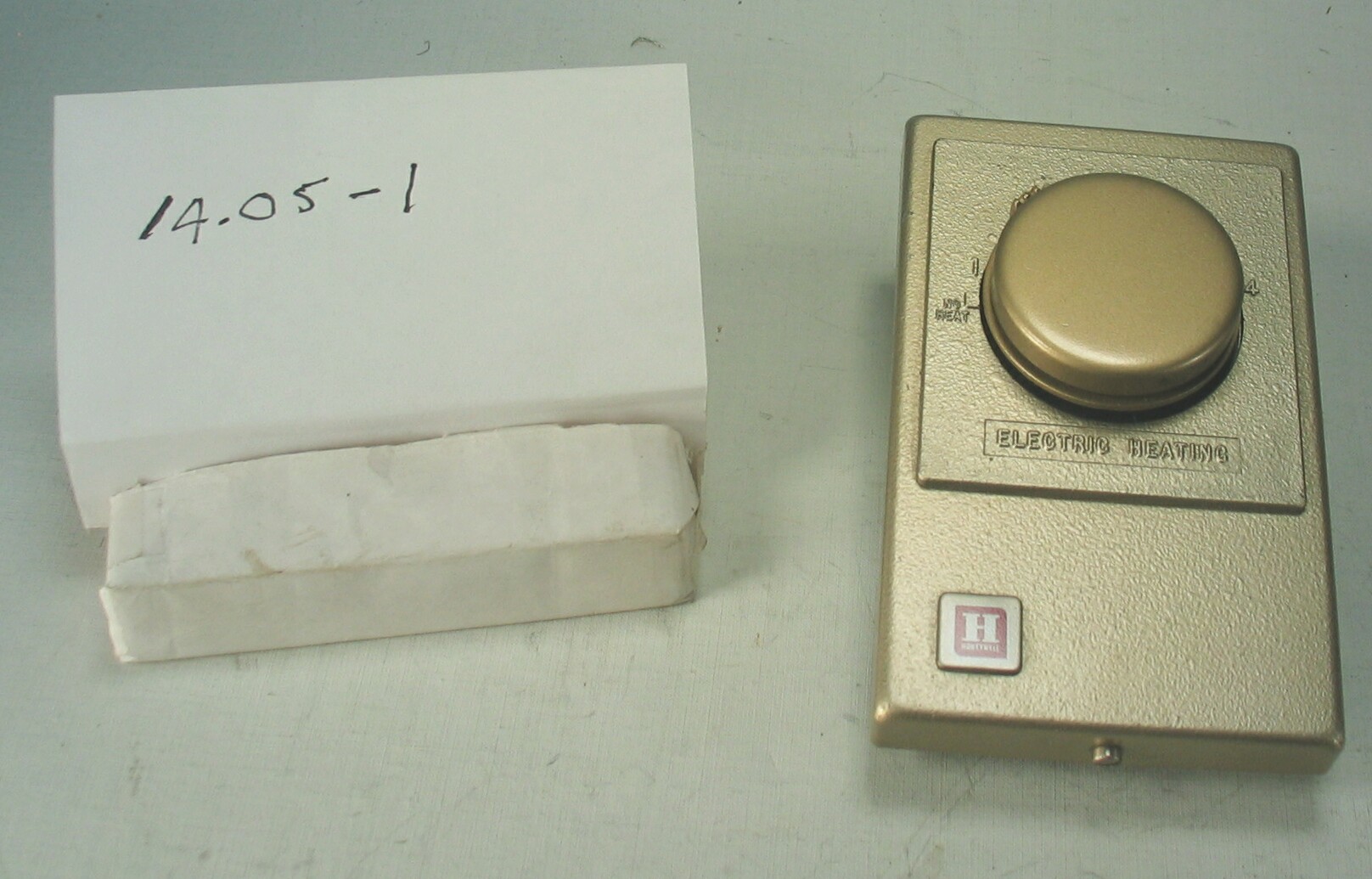14.05-1: Minneapolis Honeywell 1959 Electric Space Heating Thermostat

| HHCC Accession No. 2006.097 | HHCC Classification Code: 14.05-1 |
|---|
Description:
An electric space heating thermostat, a marker of what would prove to be a relatively short blip in time when electrical energy in much of Canada was plentiful and highly promoted for residential space heating. With 21 ampere capacity, conveniently configured for mounting on a standard electrical wall box, it is decorated with red logo and stencilled ‘Electric Heating’, in Honeywell’s then well known, high style gold-look, Honeywell T46, circa 1959. [See also ID # 224]
Group:
14.05 Electric Heating Equipment - Room Temperature Thermostats
Make:
Minneapolis Honeywell
Manufacturer:
Minneapolis Honeywell, Regulator Co
Model:
T460A or B
Serial No.:
Size:
3 x 1.5 x 4.5 ‘h
Weight:
4 ozs.
Circa:
1959
Rating:
Exhibit, education, and research quality, illustrating the styling and engineering design of mid 20th century electric heating thermostatic controls, part of the electric space heating systems highly marked by many Canadian electric utilities for residential use in the period.
Patent Date/Number:
Provenance:
From York County (York Region) Ontario, once a rich agricultural hinterlands, attracting early settlement in the last years of the 18th century. Located on the north slopes of the Oak Ridges Moraine, within 20 miles of Toronto, the County would also attract early ex-urban development, to be come a wealthy market place for the emerging household and consumer technologies of the early and mid 20th century.
This artifact was discovered in the 1950’s in the used stock of T. H. Oliver, Refrigeration and Electric Sales and Service, Aurora, Ontario, an early worker in the field of agricultural, industrial and consumer technology.
Type and Design:
line voltage, wall mounted, configured for mounting on standard electrical boxes,
Construction:
Material:
Special Features:
decorated in the then familiar, sophisticated, high style gold-look established by Honeywell in their round series of thermostats, handsome Honeywell logo in red, and marked ‘Electric Heating’, a social prestige symbol of the period
Accessories:
Capacities:
21 ampere capacity for non-inductive loads
Performance Characteristics:
Operation:
Control and Regulation:
Targeted Market Segment:
Consumer Acceptance:
Merchandising:
Market Price:
Technological Significance:
With high capacity 21 ampere, non inductive load rating, built on a simple all plastic platform, the thermostat exemplifies the sophistication of engineering and manufacturing methods achieved in the period.
Industrial Significance:
The line voltage, electric space heating thermostat would be popular in many of the housing developments of the period. Much less costly then the low voltage counterparts, it would become a common place in the electrically heated housing developments of 60’s through 80’s, as well as in some custom building.
Socio-economic Significance:
Much like the earlier thermostats of the 1920’s [See ID # 213 to 219] this thermostat, too, would be a marker of significantly changing times in Canada. Clearly evident on the wall, decorated in red and gold, it would be a new kind of marker of ‘conspicuous consumption’ in the 60’s to 80’s in much of Canada. It was a period when automatic electrical heating was successfully being promoted as clean heat, free of mechanical equipment and encumbrances and attendant worries for the householder. The wall thermostat, clearly marked ‘electric heating’ would be a prestige simple, serving to tell all of the latest and the best the Canadian heating industry could offer.
It was a marker also of that relatively brief period in the middle years of the 20th century, following W.W.II., in which there was great expectations for the future development of electrical utilities and the attendant need to build markets to support the economic costs of the development of requisite new generating capacity. The realities, social and economic costs and limits, on the development of electrical generation capacity would shortly follow, as the possibilities for vast hydro generation projects, once anticipated, diminished and as experience with both thermal and nuclear generation accumulated.
Socio-cultural Significance:
Donor:
G. Leslie Oliver, The T. H. Oliver HVACR Collection